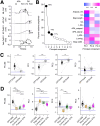Directional Subthalamic Deep Brain Stimulation Better Improves Gait and Balance Disorders in Parkinson's Disease Patients: A Randomized Controlled Study
- PMID: 39475137
- PMCID: PMC11683173
- DOI: 10.1002/ana.27099
Directional Subthalamic Deep Brain Stimulation Better Improves Gait and Balance Disorders in Parkinson's Disease Patients: A Randomized Controlled Study
Abstract
Objective: To investigate the effects of directional subthalamic deep brain stimulation (STN-dDBS) on gait and balance disorders, including freezing of gait (FOG), in patients with advanced Parkinson's disease (PD).
Methods: We included 10 participants who underwent STN-DBS and presented severe preoperative FOG, in a randomized, double-blind, crossover study. We used segmented DBS electrodes to investigate whether directing the predicted volume of tissue activated (VTA) to overlap the central STN preferentially improved gait and balance disorders compared to directional DBS applied in the more posterior STN (sensorimotor). We also assessed non-directional (ring-mode) STN-DBS. Our primary outcome was gait and balance control measured using instrumented gait recordings. Each patient had a pre-operative structural and diffusion-weighted imaging to model individual VTAs and to examine cortico-subthalamic connectivity. We used linear mixed-effects models to contrast the effects of central STN-dDBS, posterior STN-dDBS, and ring-mode STN-DBS.
Results: Central STN-dDBS produced significantly better improvement in gait and balance control compared to posterior STN-dDBS (p = 0.027), with fewer FOG episodes (p < 0.001). Conversely, ring-mode STN-DBS resulted in worsened postural control compared to central STN-dDBS (p = 0.009). The cortico-subthalamic connectivity with the STN VTAs involved mostly primary sensorimotor, premotor, and medial frontal cortices, with a higher overall cortico-STN connectivity with ring-mode STN-DBS.
Interpretation: Central STN-dDBS represents the best option to improve gait and balance disorders in PD patients, including FOG. Our findings raise the possibility of reprogramming STN-DBS toward the central area in selected patients with disabling FOG and/or postural instability after surgery. ANN NEUROL 2024.
© 2024 The Author(s). Annals of Neurology published by Wiley Periodicals LLC on behalf of American Neurological Association.
Conflict of interest statement
S.C., N.T., M.Y., G.T., J.P., D.Z., M.R., S.D., D.M., S.F.V., E.B., B.L., and M.L.W. have nothing to report. E.H. and C.K. report honoraria and consultation fees from Boston Scientific who manufactures the medical devices used in the study.
Figures






References
-
- Perez‐Lloret S, Negre‐Pages L, Damier P, et al. Prevalence, determinants, and effect on quality of life of freezing of gait in Parkinson disease. JAMA Neurol 2014;71:884–890. - PubMed
-
- Kempster PA, Williams DR, Selikhova M, et al. Patterns of levodopa response in Parkinson's disease: a clinico‐pathological study. Brain 2007;130:2123–2128. - PubMed
Grants and funding
LinkOut - more resources
Full Text Sources

